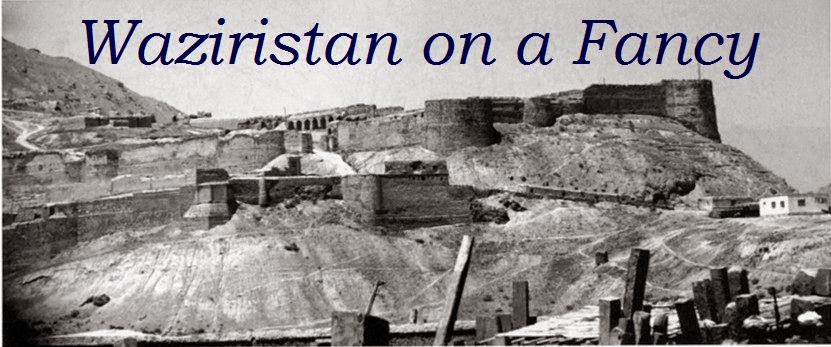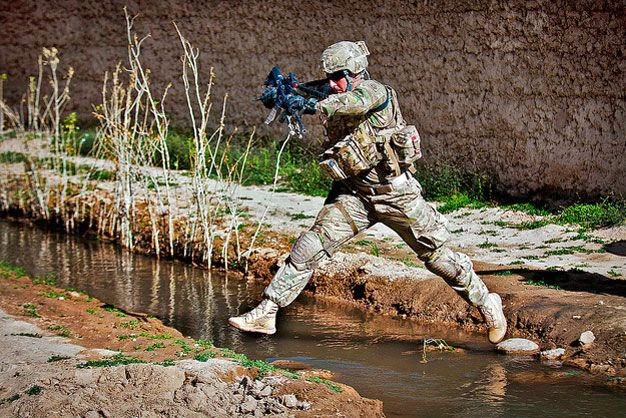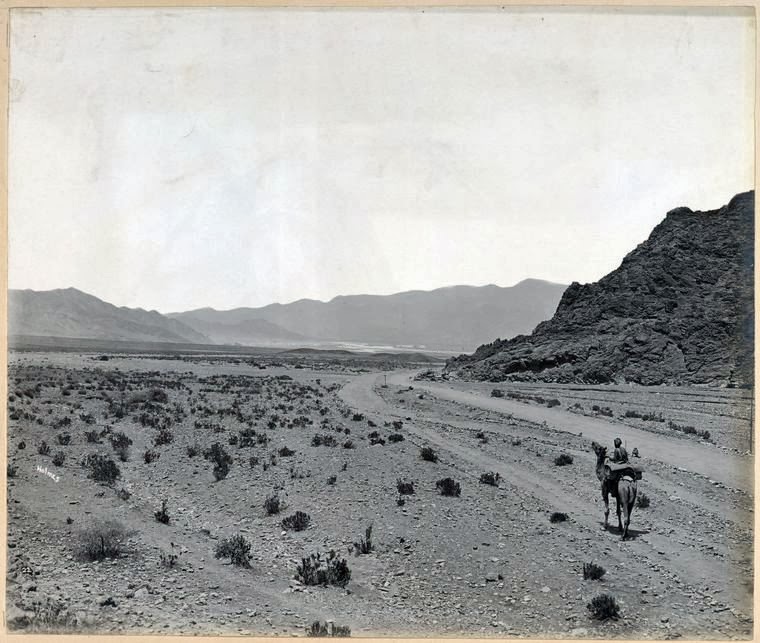Background and development.
Operation Red Wings was a combined operation realized by the Second
Battalion, 3rd Marine Regiment (2/3 Marines), with the use of some
Special Operations Forces (SOF) for the opening phase (the most famous, in
fact), in the Pech District of Afghanistan´s Kunar Province, on the slopes of a
mountain named Sawtalo Sar, from 27th June through mid-July 2005. It
was intended to disrupt local Anti-Coalition Militia activity in the region,
carried out most notably by a local “warlord” from Nangarhar Province, Ahmad
Shah.
By the summer of
2005, many of Afghanistan´s provinces had stable security environments, but one
really restive was the Kunar Province, in eastern Afghanistan, on the border
with Pakistan. Insurgent activity during this time came from around 20 groups
which ranged in allegiance from those with tenuous ties to the Taliban and
al-Qaeda to the majority of them that were little more than local (and very
well armed) criminals. These groups were known as Anti-Coalition Militia (ACM)
and military operations in Kunar focused primarily in their disruption.
In April 2005, 3/3
Marine had been deployed to Regional Command (East) RC (E) from late 2004, and
had conducted a number of stability and counterinsurgency operations in support
of Operation Enduring Freedom that
proved very successful in disrupting ACM activity. The culmination of these
efforts was the April 2005 surrender of a regional “high value target” (HVT),
the ACM commander Najmudeen, who had based his operations in the Korengal Valley.
With his surrender, ACM activity in the region dropped significantly, but he
had left a power vacuum in the area, so 3/3 Marine tracked a number of known
ACM groups which could possibly wanted to fill the power void.
It was the next USMC
unit posted in the area, the 2/3 Marine who found and selected the target for
their first operation in the same line as those from 3/3. This time, it was the
small cell led by Ahmad Shah, responsible of eleven incidents against Coalition
forces, with aspiration to impede the upcoming elections and to aid a resurgent
Taliban in the region. According to the intelligence gathered, he had fifty to
a hundred fighters in his group.
By June 2005, 2/3
Marine had developed a comprehensive operation called Operation Red Wings (“Red Wings” being the name of an US hockey
team).
 |
| Ahmad Shah |
Operation Red Wings.
Ahmad Shah based his
insurgent operations near some small structures outside of the village of
Chichal, on the slopes of Sawtalo Sar mountain, in the upper Korengal Valley
(the “Valley of Death” for the US forces) and twenty miles to the west of
Kunar´s provincial capital, Asadabad. The intelligence staff of the 2/3 Marine determined
Shah could be there in late June and they prepared an operation that would
require a helicopter insert of forces to cordon the area and search for Shah in
a direct assault after a positive identification by a Marine Corps Scout/Sniper
team which would walk into the area under cover of darkness some nights before
the assault.
It was an USMC
operation in the AOR (area of operations) of the 2/3 Marine, who, as additional
assets, sought only to use the MH-47 of the 160th SOAR (A), the
Special Operations Aviation Regiment (Airborne). However, CJSOFT-A, the
Combined Joint Special Operations Task Force-Afghanistan, refused this request,
stating that in order for Red Wings
to be supported with Special Operations aviation, the 2/3 Marine would have to
task the opening phases of the operation to Special Operations Ground Forces,
with the Marines of 2/3 acting in a supporting role until after the initial
phases of the operation. The battalion agreed to this condition despite this
agreement defied a fundamental “unity of command” rule for the success of any operation. This one was presented to a number of Special Operations units
working in the area for possible “buy in” and US Navy SEALs expressed interest, so they received the task to perform the first two phases of the operation.
The operation.
In Phase One of the
operation, an US Navy SEAL reconnaissance and surveillance team was tasked to
insert in the region, observe and identify Ahmad Shah and his men, and guide
the assault forces of Phase Two, in which a SEAL direct action
team was to be inserted by MH-47, followed by Marines, to capture or kill Shah
and his men.
Then, the Marines and
Afghan National Army forces could conduct the next three phases of the
operation, those of outer cordon, security and stabilization (the most mundane
of them, of course).
Late in the night of
June 27, 2005, two MH-47 of the 160th SOAR (A) approached Sawtalo
Sar. While one of them performed a number of “decoy drops” to confuse the
enemy, the other inserted via fastrope a four-man SEAL reconnaissance and
surveillance team (formed by two sniper teams) in a saddle between Sawtalo Sar
and Gatigal Sar, one and half miles from the nearest Named Area of Interest
(NAI) of the mission.
After a hard night
march, the team reached a pre-determined, covered overwatch position (number one in the map), from
which the SEALs could observe the different NAIs, but it was not a very good
place, so they look for another OP near Chichal (number two). Sadly, in this one, the team
was quickly discovered by local goatherds, which were released according to the
rules of engagement. The team, surmising that they have been compromised,
retreated to a fallback position near the summit of the mountain, but, within
an hour, they were ambushed by Shah and his men. The SEALs were suddenly
attacked by RPK light machine guns, AK-47s, RPG-7 rocket propelled grenades and
an 82mm mortar with such intensity that this volume of fire, combined with the
type of ambush, from a higher position, forced the SEAL team mountain down into
the northeast gulch of Sawtalo Sar.
The SEALs made a
number of attempts to contact their combat operation center, before and after
the ambush, but they could not establish consistent communication, being only
able to indicate that they were under attack. Three of the four team members
were killed by the Afghans and the only survivor, Marcus Luttrell, was left
unconscious and seriously wounded, but the Afghans lost his track. Finally, after
a long and hard march on foot, he was rescued by a local Pashtun from Salar Bar
village, who saved his life, hiding him from the Taliban.
The Rescue mission, Red Wings II.
After the
communication that the SEAL team was under attack, the focus of the operation
shifted from disrupting ACM activity to finding and extracting the SEALs. Some
hours after the desperate communication of the SEAL team (because its position
and situation were unknown due to the broken transmission), a quick reaction
force (QRF) was finally launched, consisting of two MH-47 of the 160th,
two UH-60 and two AH-64 Apache, with the two MH-47 on the lead. Upon reaching
Sawtalo Sar, the two MH-47 received small arms fire but they didn´t wait for
the Apaches and, in the attempt to insert the SEALs who were riding in one of
the MH-47, one of Ahmad Shah´s men fired an RPG-7 which, entering by the rear
door, struck the transmission below the rear rotor assembly, causing the
aircraft to immediately plummet to the ground, killing all eight 160th
aviators and crew and all eight US Navy SEALs who were passengers. Both
commanders of the rescue force, LCDR Erik S. Kristensen of SEAL Team 10 and
aviation element commander Major Stephen C. Reich of 160th, were
killed, so command and control of the rescue mission was lost, ending the first
attempt of rescue.
The second attempt
was a massive and better organized search and rescue operation, and all the
bodies were recovered and Marcus Luttrell was also rescued, some days after the
ambush, in the village of Salar Ban, roughly one mile down the location of the
fight.
 |
| The rescue team, looking for Axelson |
Code of Honour.
The SEALs´ firefight
with Ahmad Shah´s forces began along a high-elevation ridgeline called Sawtalo
Sar and the north-eastern gulch in which the SEALs were trapped was in the
direction of the small village of Salar Ban. The wounded Luttrell descended the
gulch and was encountered by a Pasthun named Mohammad Gulab Khan from Salar
Ban, who took Luttrell into his home and, according with the cultural tradition
of Pashtunwali, offered him
protection from his enemies. Full protection.
Ahmad Shah, “king of
the mountain”, was able to ascertain where the wounded SEAL was, and demanded
that he be turned over, a demand that was not attended by the villagers. He
could not risk a fight at that moment, with a number of his men killed during
the battle with the SEALs and so many enemies coming to the valley so, in the
end, he was unable to capture Luttrell.
 |
| Red arrows indicate the Insurgent´s fire lanes |
Aftermath.
Ahmad Shah and his
group recovered a large amount of weapons, ammunition and other material,
including a laptop with an intact hard drive containing maps of embassies in
Kabul and other documents. Shah had with him two videographers during the
ambush, and released a video of the ambush and the items recovered from the
SEALs so his victory was soon on the media.
Thanks to the ambush
and the MH-47 shootdown, the size of his group increased as additional fighters
joined his ranks up to 100. In this way, he gained an amount of notoriety and became a valued target for the Coalition forces, but
he was finally killed in April 2008 during a shootout with Pakistani police.
Disputed Information.
There is some conflict
over the exact number of Taliban forces involved in the engagement and about
the mission of the SEAL team.
Operation Red Wings was an USMC operation that integrated Special
Operations assets for the opening phases of the mission, but a four man SEAL team
was not sent in a covert mission to kill or capture Ahmad Shah as it has been
shown in “Lone Survivor”. Shah was not one of Osama bin Laden´s lieutenants,
neither was he an HVT (High Value Target); he was just another chief of ACM or
Anti-Coalition Militia, and not a “big player”. His force was put by initial
INTEL at up to 20 ACM and it was very logical because the small villages on the
Korengal Valley/Sawtalo Sar and Shuryek Valley cannot sustain a number of
fighters larger than these for very long.
The problem is that,
in Luttrell´s own official after-action report, he estimated the size of the
Taliban force to be around 20-35 but in his book he claimed that, during the
briefing, they were told around 80 to 200 fighters were expected to be in the
area. Further analysis, derived from signals intelligence gleaned during the
ambush and human intelligence derived in Pakistan after the ambush, stated the
number of Taliban fighters to be between 8 and 10 probably reinforced during
the fight.
It is, in the end, an
exercise of “Afghan Math” (“just divide by about ten to get the real number”).
Of course, it is not
good for the “Stars and Stripes” culture. The narrative of a four-man team of
hard Navy SEALs fighting on a group of hundreds of “hostiles” under the
leadership of the right-hand man of THE enemy has all the elements for a great
military action thriller. But it didn´t happen in Red Wings.
The sober true is
that Ahmad Shah, with around half of his retinue,
surrounded the SEALs by up to 180º and fired at them from superior positions
(higher terrain, the recipe for the exit) with weapons of heavier calibre than
the SEALs´ 5.56mm. Shah had at least one RPG with a lot of rockets, a number of
men firing AK-47s, a pair of PK machine guns and possibly an 82mm mortar, this
one able to wipe out, alone, a team much larger than four men. It was something
very hard to accept by the Special Operators community, but the SEALs were
vastly outgunned and outpositioned by an enemy that had excellent cover from
the thick forest surrounding the Northeast Gulch of Sawtalo Sar, who knew the
terrain very well (so were able to surround quickly the SEALs) and who
coordinated a fierce combined-arms attack utilizing a variety of powerful
weapons fired at a steep, narrow, funnel-like terrain.
This was nothing more than an excellent
ambush.
“Lone Survivor”.
In early June 2007,
the book “Lone Survivor: The eyewitness Account of Operation Redwing (sic) and
the Lost Heroes of SEAL Team 10” was released. Marcus Luttrell was the author
and Patrick Robinson, the contributor. There were a number of big
contradictions with the real operation: the USMC involvement was omitted; the
name of the operation was wrong, the number of enemy fighters was exaggerated,
the US Intelligence believing in the close links between Ahmad Shah and Osama
bin Laden was an outright fabrication...
In the end, it was
clear that “Lone Survivor” has been written entirely by Patrick Robinson (a
British writer specialized in military fiction titles), based on unrecorded
interviews of Marcus Luttrell. Probably, as Robinson never contacted any
Marines, he could not have known the full scope of the operation so it was, for
him, a Navy special operation targeting one of bin Laden´s top lieutenants.
But there is a point in common related to the fiction and the real mission: "Civilians are not targets!", the most relevant line in the ROE (Rules of Engagement) cards issued to the US Military and the one which cost the lives of so many good men.
This movie put me on the search of more information about this small skirmish in the mountains. It is a very interesting and very well done movie, but too much based in Patrick Robinson´s book, IMHO, so it is not complete nor correct.
This is the book, based in Marcus Luttrell experience in Sawtalo Sar, and it is easy to find in its pages one of the reasons of this disaster: the contempt towards a (theoric) primitive opponent who, in the end, was able to prepare and launch a perfect attack against a team of super-soldiers.
I like the SEALs´ training chapters in the book more than those of the mission...
This is another book I have read; this time, about the rescue mission. It is incredible to read how difficult it was for the great super-power U.S.A. to rescue these men in that distant mountain, with the Insurgents attacking them right to the end! A lot of gaming ideas for different games!
Of course, I have these figures ready to be painted (first, I need to finish some SASs, and I have also written an scenario for "Skirmish Sangin" based in this small battle, to test the future "Taliban ORBAT" from Radio DishDash.









































